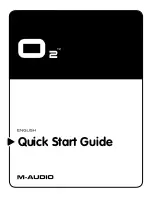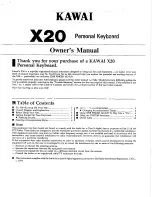
KDFX Reference
KDFX Algorithm Specifications
10-91
Page 2
Page 3
In/Out
When set to “In”, the quantizer and
fl
anger are active; when set to “Out”, the quantizer
and
fl
anger are bypassed.
Out Gain
The overall gain or amplitude at the output of the effect.
Quant W/D
The relative amount of quantized (wet) to unaffected (dry) signal passed to the
fl
anger. At
100%, you hear only quantized signal pass to the
fl
anger.
Flange W/D
The relative amount of input signal (from the quantizer) and
fl
anger signal that is to
appear in the
fi
nal effect output mix. When set to 0%, the output is taken only from the
quantizer (dry). When set to 100%, the output is all wet. Negative values polarity invert
the wet signal.
DynamRange
The digital dynamic range controls signal quantization, or how many bits to remove from
the signal data words. At 0 dB the hottest of signals will toggle between only two bit (or
quantization) levels. Every 6 dB added doubles the number of quantization levels. If the
signal has a lot of headroom (available signal level before digital clipping), then not all
quantization levels will be reached.
Headroom
When the signal has a lot of headroom (available signal level before digital clipping),
turning down DynamRange can cause the amplitude of adjacent quantization levels to
exceed the input signal level. This causes the output to get very loud. Set Headroom to
match the amount of digital signal level still available (headroom). This is easily done by
fi
nding the DynamRange level at which the signal starts getting louder and matching
Headroom to that value.
dc Offset
Adds a positive dc Offset to the input signal. By adding dc Offset, you can alter the
position where digital zero is with respect to you signal. At low DynamRange settings,
adding dc Offset can may the output sputter. dc Offset is expressed in decibels (dB)
relative to full scale digital.
Fl Tempo
Basis for the rates of the LFOs, as referenced to a musical tempo in bpm (beats per
minute). When this parameter is set to “System”, the tempo is locked to the internal
sequencer tempo or to incoming MIDI clocks. When it is set to “System”, sources (FUNs,
LFOs, ASRs etc.) will have no effect on the Tempo parameter.
Fl Period
Sets the LFO rate based on the Tempo determined above: the number of beats
corresponding to one period of the LFO cycle. For example, if the Fl Period is set to “4”,
the LFOs will take four beats to pass through one oscillation, so the LFO rate will be 1/4th
of the Tempo setting. If it is set to “6/24” (=1/4), the LFO will oscillate four times as fast as
Fl Tempo
System, 1 to 255 BPM
Fl Fdbk
-100 to 100%
Fl Period
0 to 32 bts
Fl L Phase
0.0 to 360.0 deg
Fl R Phase
0.0 to 360.0 deg
Fl StatLvl
-100 to 100%
Fl LFO Lvl
-100 to 100%
FlStatDlyC
0.0 to 230.0 ms
Fl Xcurs C
0.0 to 230.0 ms
FlStatDlyF
-127 to 127 samp
Fl Xcurs F
-127 to 127 samp
Fl Delay C
0.0 to 230.0 ms
Fl Delay F
-127 to 127 samp
Содержание K2661
Страница 18: ...2 4 LFOs LFO Shapes...
Страница 34: ...3 16 DSP Algorithms...
Страница 54: ...5 4 MIDI Note Numbers Note Numbers for Percussion Keymaps...
Страница 72: ...7 10 System Exclusive Protocol K2661 System Exclusive Implementation...
Страница 82: ...9 4 Upgrading Sample Memory Choosing and Installing a SIMM for K2661 Sample Memory...
Страница 334: ...10 252 KDFX Reference KDFX Algorithm Specifications...
Страница 340: ...11 6 Glossary...
Страница 382: ...12 42 Triple Modular Processing Alphanumeric Buttonpad Entries for DSP Functions...
Страница 392: ...B 6 SysEx Control of KDFX MSB and LSB...
Страница 442: ...D 20 Contemporary ROM Block Objects Controller Assignments Contemporary ROM Block...
Страница 490: ...H 12 General MIDI Standard Mode Controller Assignments...
Страница 492: ...I 2 Live Mode Objects Live Mode Programs...
Страница 498: ...K2661 Musician s Reference Index...
Страница 500: ......
















































